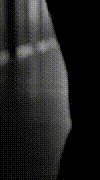A History Lesson for Red....
Our modern celebration of Halloween is a descendent of the ancient Celtic fire festival called "Samhain". The word is pronounced "sow-in", with "sow" rhyming with cow.
The Celts believed that when people died, they went to a land of eternal youth and happiness called Tir nan Og. They did not have the concept of heaven and hell that the Christian church later brought into the land. The dead were sometimes believed to be dwelling with the Fairy Folk, who lived in the numerous mounds or sidhe (pron. "shee") that dotted the Irish and Scottish countryside. Samhain was the new year to the Celts. In the Celtic belief system, turning points, such as the time between one day and the next, the meeting of sea and shore, or the turning of one year into the next were seen as magickal times. The turning of the year was the most potent of these times. This was the time when the "veil between the worlds" was at its thinnest, and the living could communicate with their beloved dead in Tir nan Og.
The Celts did not have demons and devils in their belief system. The fairies, however, were often considered hostile and dangerous to humans because they were seen as being resentful of men taking over their lands. On this night, they would sometimes trick humans into becoming lost in the fairy mounds, where they would be trapped forever. After the coming of the Christians to the Celtic lands, certain of the folk saw the fairies as those angels who had sided neither with God or with Lucifer in their dispute, and thus, were condemned to walk the earth until judgment day.(3) In addition to the fairies, many humans were abroad on this night, causing mischief. since this night belonged neither to one year or the other, Celtic folk believed that chaos reigned and the people would engage in "horseplay and practical jokes".(4) This served also as a final outlet for high spirits before the gloom of winter set in.
During the course of these hijinks, many of the people would imitate the fairies and go from house to house begging for treats. Failure to supply the treats would usually result in practical jokes being visited on the owner of the house. Since the fairies were abroad on this night, an offering of food or milk was frequently left for them on the steps of the house, so the homeowner could gain the blessings of the "good folk" for the coming year. Many of the households would also leave out a "dumb supper" for the spirits of the departed.(5) The folks who were abroad in the night imitating the fairies would some- times carry turnips carved to represent faces. This is the origin of our modern Jack-o-lantern.
Celtic religion was very closely tied to the Earth. Their great legends are concerned with momentous happenings which took place around the time of Samhain. many of the great battles and legends of kings and heroes center on this night. Many of the legends concern the promotion of fertility of the earth and the insurance of the continuance of the lives of the people through the dark winter season.
When the potato crop in Ireland failed, many of the Irish people, modern day descendents of the Celts, immigrated to America, bringing with them their folk practices, which are the remnants of the Celtic festival observances.
The Celts had 3 harvests: Aug 1, or Lammas, was the first harvest, when the first fruits were offered to the Gods in thanks. The Fall Equinox was the "true harvest". This was when the bulk of the crops would be brought in. Samhain was the final harvest of the year. Anything left on the vines or in the fields after this date was considered blasted by the fairies, or "pu'ka", and unfit for human consumption.
Many followers of various pagan religions, such as Druids and Wiccans observe this day as a religious festival. They view it as a memorial day for their dead friends, similar to the national holiday of Memorial Day in May. It is still a night to practice various forms of divination concerning future events. Also, it is considered a time to wrap up old projects, take stock of ones life, and initiate new projects for the coming year. As the winter season is approaching, it is a good time to do studying on research projects and also a goot time to begin hand work such as sewing, leather working, woodworking, etc. for Yule gifts later in the year.
Do try to learn your history as to the origins of Halloween before you go slathering about blaming "America" for the traditions associated with Halloween. Now pull that broom out of your ass and give it back to the exasperated witch that stuck it there.
Mimi








